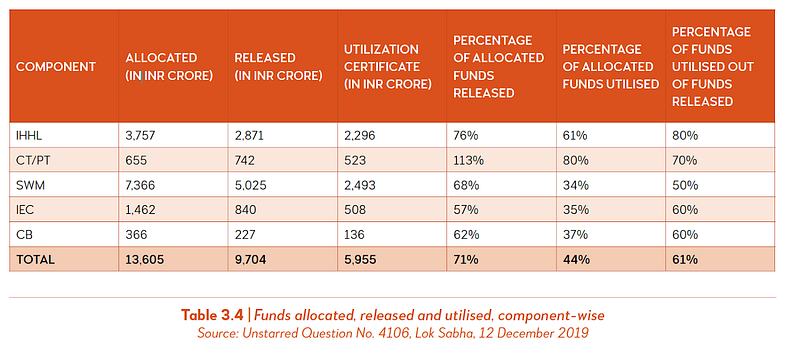
On 8 February 2021, India’s Finance Minister Nirmala Sitharaman presented the Union Budget 2021–22. Along with large sums for healthcare and transportation infrastructure, increased privatisation and changes to tax proposals, she also announced the launch of the Urban Swachh Bharat Mission 2.0, which will be implemented from 2021–2026.
With India’s fiscal deficit at 9.5 per cent in 2020–21, and the aim to reduce it to 6.8 per cent in 2021–22, the government must allocate and utilise funds equally and efficiently. We can learn from the past as we move into the future. The Prime Minister had announced the initial Swachh Bharat Mission during his first Independence Day Speech in 2014. It had two parts — Urban (SBM-U) and Grameen (SBM-G). SBM-U promised to make all urban areas Open Defecation Free and ensure 100% scientific disposal of municipal solid waste. The initial budget allocation for SBM–U for 2014–2019 was INR 14,623 crore.
The total budget allocation for Urban Swachh Bharat Mission 2.0 between 2021–2026 is INR 1,41,678 crore. This is almost 10 times the amount announced for Phase 1.
Youth for Unity and Voluntary Action (YUVA’s) Parliamentary Watch Report, 2019 analysed the implementation of SBM-U Phase 1 and found several data discrepancies and funding issues, which raises questions about the increased budget for Phase 2 and how it will be used.
In Phase 1, only 71 per cent of the 14,623 crore allocated was released and only 44 per cent of the funds allocated had been utilized, as of 2019. Some States and Union Territories (UTs) had utilised less than 50 per cent of the released funds. However, despite these insufficient funds, most components under the scheme claim to have achieved their targets and the aforementioned States and UTs are displaying performance rates exceeding 100 per cent. This is not due to exceptional financial intelligence, but due to a constant revision of campaign targets to maintain the appearance of success.
One objective of SMB-U Phase 1 was to create 1.04 crore individual household latrines (IHHLs). This target was then revised to 66.4 lakh as of February 2019 and further revised in October 2019 to 54.71 lakh, to inflate the success rate from 92 per cent to 106 per cent. Between February and October, individual State targets were also revised, increasing the targets for overperforming States and reducing them for underperforming ones, to create an overall average positive performance (see Table 3.1 from the report). Hence, there is a 106 per cent success rate in building IHHLs despite only 61 per cent of the funds allocated being utilised.

There is a greater focus on image than impact when implementing these schemes. Even in the case of building Public and Community Toilets, SBM-U Phase 1 shows a 111 per cent achievement rate, but almost 70 per cent of the toilets constructed are concentrated in 5 states. 13 states and UTs overperformed while 18 of them were unable to achieve their targets. Similarly, under the Solid Waste Management objective, 275 waste processing plants are under construction but almost 70 per cent of them are concentrated in 4 States, and not the top 4 highest waste generating States. This lopsided distribution of funds and efforts must be addressed in the second phase of the Urban Swachh Bharat Mission, to make it more equitable and a truly national scheme.
The Solid Waste Management component was the least successful part of the scheme, building capacity to process only 58 per cent of solid municipal waste generated. Therefore, an important focus of Phase 2 is ‘complete faecal sludge management and waste water treatment’. However, in Phase 1 only 34 per cent of the funds allocated for Solid Waste Management projects were utilized. Table 3.4 of the report shows a trend where funds were underutilised in every component of the scheme, with 3 out of 5 using less than 50 per cent of the funds allocated.

While an increased budget allocation for Phase 2 emphasises the Government’s intentions to promote urban sanitation and health, its funding processes need to be more efficient to create real impact. Adding more money to a project without properly utilizing old funds is ineffective. Other issues faced like zero utilisation in 2015–2016 due to a delay in release of funds or waiting till the end of the five year period to release funds should be addressed and overcome in Phase 2.
Phase 2 is also shifting the focus from individual sanitation to other areas like ‘source segregation of garbage, reduction in single-use plastic, reduction in air pollution by effectively managing waste from construction-and-demolition activities and bio-remediation of all legacy dump sites.’ While expanding our goals is important, achieving and maintaining previous goals is equally important. The new scheme should consider ways to achieve the initial, unrevised targets set in Phase 1 and also maintain the new infrastructure constructed so far.
Another issue to be addressed at the planning stage is who this mission aims to serve in urban areas. In Phase 1, unauthorised colonies were excluded while assessing the demand for household toilets. These are usually low income neighborhoods where there is a great need for proper sanitation. Not considering the citizens living there while creating a national programme makes it unjust and discriminatory. The Urban Swachh Bharat Mission 2.0, strengthened by a substantial new budget, should strive to be more efficient and equitable and focus on making progress not on paper but in people’s lives.
Niyoshi Parekh, Brown University. Niyoshi is currently interning with YUVA.


